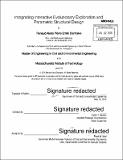Integrating interactive evolutionary exploration and parametric structural design
Author(s)
Danhaive, Renaud Aleis Pierre Emile
DownloadFull printable version (8.302Mb)
Other Contributors
Massachusetts Institute of Technology. Department of Civil and Environmental Engineering.
Advisor
Caitlin T. Mueller.
Terms of use
Metadata
Show full item recordAbstract
Current modeling and analysis tools are extremely powerful and allow one to generate and analyze virtually any structural shape. However, most of them do not allow designers to integrate structural performance as an objective during conceptual design. As structural performance is highly linked to architectural geometry, there is a need for computational strategies allowing for performance-oriented structural design in architecture. In order to address these issues, this research combines interactive evolutionary optimization and parametric modeling to develop a new computational strategy for creative and high-performance conceptual structural design. Parametric modeling allows for quick exploration of complex geometries and can be combined with analysis and optimization algorithms for performance-driven design. However, this methodology often questions the designer's authorship as it is based on the use of black-box optimizers. On the other hand, interactive evolutionary optimization empowers the user by acknowledging his or her input as fundamental and includes it in the evolutionary optimization process. This approach aims at improving the structural performance of a concept without limiting the creative freedom of designers. Taking advantage of the two frameworks, this research implements an interactive evolutionary structural optimization framework in the widely used parametric modeling environment constituted by Rhinoceros and Grasshopper. Previous work has illustrated the benefits of combining parametric modeling and genetic algorithms for design space exploration. Comparatively, the implemented design tool capitalizes on Grasshopper's versatility for geometry generation but supplements the visual programming interface with a flexible portal increasing the designer's creative freedom through enhanced interactivity. The tool can accommodate a wide range of structural typologies and geometrical forms in an integrated environment. This research offers a versatile, performance- and user-oriented environment for creative and efficient conceptual structural design.
Description
Thesis: M. Eng., Massachusetts Institute of Technology, Department of Civil and Environmental Engineering, 2015. Cataloged from PDF version of thesis. Includes bibliographical references (pages 47-48).
Date issued
2015Department
Massachusetts Institute of Technology. Department of Civil and Environmental EngineeringPublisher
Massachusetts Institute of Technology
Keywords
Civil and Environmental Engineering.